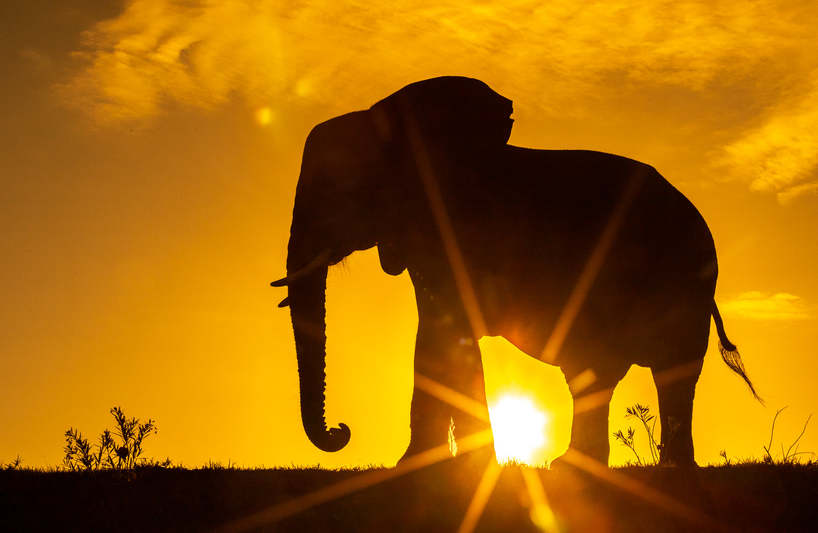The Huge African Elephant Balancing Act

When one thinks of African sunset safaris and the tall grass of the savannah, the imagery is not complete without the magnificent silhouette of elephants against the gold and orange sky. The African elephant is an iconic species of the bush, and here at Kariega Game Reserve in South Africa we hold our elephants in extremely high regard. Elephants form a rich and integral part of our history and have a huge cultural significance. We have been charged with taking care of our elephant herds in order to maintain their physical, emotional and social well-being. A job which requires a huge African elephant balancing act.
African elephants have been co-existing with humans for hundreds of years. However, due to the vast increase in, and spread of our human population in modern times, and loss of natural habitats as a result, the available land left for wild animals is severely limited and far from its natural state. Coupled with restrictions to their movements in what would have been their historical habitats this has lead to a significant shift in their behaviours.
In other words, just because these elephants are in the wild, the dynamics of the herd are not as they once would have been as result of human involvement. Therefore, as conservationists, it is our duty to determine innovative and sustainable methods in which to ethically manage the herds.

Ongoing African Elephant Research at Kariega Game Reserve
One vital tool that we rely on to help to maintain the elephant balancing act is ongoing research. Kariega Game Reserve is fortunate to collaborate with many specialists in this field.
The latest research at Kariega commenced in January 2021 in collaboration with Antoinette Van de Water, an extremely experienced elephant researcher with a passion for human-elephant coexistence. Antoinette also operates her own foundation, Bring the Elephant Home. Antoinette has been researching Asian elephants and human-elephant conflict in Thailand for fifteen years. She has decided to explore the magic of their African cousins and is now completing her Ph.D. at the University of KwaZulu-Natal.
The encroachment of people into elephant habitats and fencing affects elephant behaviour, movement patterns and cuts off access to natural and historical corridors, altering seasonal migration. Conservation works best when local people are included in the process, so that conservation strategies that benefit them long term, as well as the elephants, are able to be developed and practiced successfully.
Antoinette’s research aims to develop mutually beneficial human-elephant coexistence strategies by using elephant observations to determine how people affect the wellbeing of elephants, and vice versa. The elephant observations focus on feedbacks, interactions and key relationships between elephants and people which, after data analysis, will allow for recommendations to be made on how supporting local livelihoods, biodiversity and elephant wellbeing can be integrated and supported in the future.
African Elephant Balancing Act Data Collection

In order to collect data for the research, Antoinette joins members from the Kariega volunteer programme and conservation interns weekly to observe the elephants.
Our first task is to create an identification code for every elephant on the reserve, so that we can describe family links and histories. This in itself is much harder than it sounds! This process uses the age (estimate), gender, physical cuts and tears and special identifying features to create a unique code for each elephant. Once an elephant has been identified, we can then start to observe its behaviour. Antoinette has formulated a custom observation sheet that identifies different behavioural displays, such as flapping of the ears (awareness/defensiveness), charging (aggression), mud bathing (relaxed), and touching other elephants with the trunk (social), to name a few.
Once happening upon a herd, the observers choose an individual to focus on and mark their displayed behaviour every two minutes, for twenty minutes, with any additional comments that may be useful. The form also includes information such as the land type (open grassland, thicket), the proximity of the elephant to the vehicle, the type of herd it is in (mixed group, lone bull etc.), the number of vehicles present and the type. All of this information helps to give context to the behaviour observed. Kariega has been actively contributing to this research by providing Antoinette with game drives throughout the elephant hotspots on the reserve, as well as providing keen observers in the form of volunteers and interns.

Research Informs Human-Elephant Interactions
The importance of this research also relates to where the behaviour of Kariega’s elephant population stands in relation to other populations where they are exposed to similar land use and also to compare elephant behaviour between areas of different land use and intensities.
The end result is that it gives us as a reserve the monitoring tool to base our decisions that consider both guests and wildlife. The information will also guide ethical safari practices regarding boundaries as to how close game drives can get to the elephants so as to not disturb them, how many vehicles can be present at a time, and how long the vehicles can remain with the elephants to ensure their comfort and well-being. We look forward to the valuable information this research will provide to us, and will hopefully display some important guidelines and suggestions for reserves across the continent to follow.
If you would like to know more about Kariega Game Reserve safaris please contact us or email reservations@kariega.co.za. If you are interested in our Kariega Conservation Volunteer Programme you can also contact us or email volunteer@kariega.co.za. You are welcome to leave a questions in the comments below.
Images thanks to Kariega head guide Wayne, senior guide Brendon and Conservation Volunteer coordinator Jaco.









